
Published in The Sun Daily & The Edge Markets, image by The Sunday Daily.
THE prime minister announced a glimpse of the National Recovery Plan (Pelan Pemulihan Negara) on June 15, whereby herd immunity has been targeted by end of this year.
For Malaysia to “get out of the woods” by that time, vaccination rate needs to be increased significantly.
Assuming the target is 27 million people (82.5% of the local population) and 2.96 million foreigner population whereby each person requires two doses, Malaysia would need to utilise 59.92 million doses.
The entire vaccine doses need to completely administered between October and November this year, and this can only be achieved under an “increasing vaccination rate scenario” which has been generally mentioned as a target by the prime minister as well as the National Immunisation Programme coordinating minister .
Under this scenario, a potential increasing rate scenario (in terms of daily average administered doses per month) could be projected as such: 150,000 in the second half of June, 250,000 in July, 350,000 in August, and 400,000 from September onwards (which is assumed here as the ceiling capacity).
For “herd immunity” to be achieved, an additional two months may be added on top of the projected completion time (October to November) to utilise all of the 59.92 million doses.
This is because the second dose is roughly three weeks after the first, and given that immunity could take three to four weeks to “kick in” after the second dose, another three to four weeks should also be added.
Therefore, a ball park period of two months is needed to be assumed after completion of doses administration to consider reaching the targeted herd immunity status.
At the moment, things are looking well on the way towards this projection given recent reports of a new peak of 215,876 administered doses on June 15.
Increased number of vaccination centres and decentralisation strategies such as empowering general practitioner clinics, private institutions, drive-through centres and use of government vehicles for vaccination campaigns to reach rural areas and the elderly are all expected to increase this capacity greatly.
However, in order for this figure to be sustained daily and increased as per the projection, two biggest bottlenecks could be vaccine shipments and local registrations.
The “increasing rate scenario” above would need the corresponding minimum vaccine doses (in millions of doses per month) of about 2.55 million for the second half of June, 7.75 million, 10.85 million, 12.4 million and 1.99 million doses for the months of July, August, September, October, and November respectively.
Given that we have ordered up to 125% of the population, and assuming deliveries are on schedule, then we should have a surplus (above the assumed herd immunity target above) by November onwards.
But just because we have ordered above 100% of our population, it doesn’t solve the speed issue.
The recent announcement of the conditional emergency approval for Sinopharm and Janssen (J&J) vaccines can potentially open more vaccine suppliers to be negotiated and purchased from.
However, even this may not solve the issue in the near term because of the overall global production limits.
That said, unprecedented times require unprecedented measures, and the authorities should explore all options to ensure timely vaccine delivery.
If, for whatever reason, we are not able to increase vaccination rate, a “flat rate” (instead of an increasing rate) of say, an average 200,000 vaccine daily administered doses can set the target back to the second quarter of next year.
As for registrations, there could be two scenarios. If the registration rate is not flattening and is more than vaccine supply, then it’s business as usual.
However, if vaccine supply is more than registration and data is plateauing, say by the end of August (as the cut-off period to observe and confirm the trend), then automatic registrations may have to be considered.
Automatic registrations, or “jab first, register later” strategies may face public backlash, especially without proper communications with the public.
This should only be considered with really strong reasoning and circumstances that can be effectively communicated with the public.
Several unknowns remain. We can’t just assume everyone receiving vaccines will develop sufficient immunity and for a sufficient amount of time.
Pharmacovigilance post vaccination needs to account for monitoring and measurement of immunological status (in addition to adverse events) to keep tabs on immunity levels and duration of retainment. This is especially concerning given continuously emerging virus variants.
Though the US Food and Drugs Administration (FDA) currently does not recommend such tests to measure immunity levels post vaccination, the information could be stored by health authorities for its own internal use, instead of public self-management.
As more research on Covid-19 antibody tests emerges, this information when combined with other patient information and links to virus variants, can potentially help measure the success towards “herd immunity”, serve as a basis for vaccine passports implementation, and can help provide guidance for further vaccine types to be procured and other pandemic management strategies.
Also note that undocumented foreign population is not included in timeline projections which, subject to their actual numbers, could add one to two months in estimates, and must be included in the vaccination programme. No one is safe until everyone is safe.
Ameen Kamal is the Head of Science and Technology at EMIR Research, an independent think tank focused on strategic policy recommendations based on rigorous research.

.jpg)